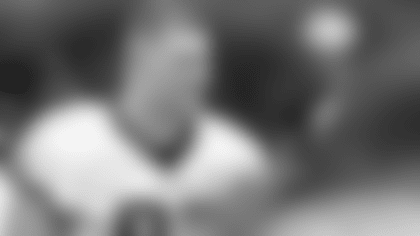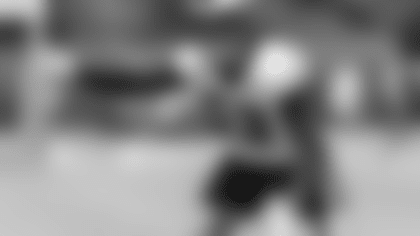You see it every time quarterback Nick Foles is in the shotgun, waiting for Jason Kelce to snap him the football. Foles will lift his leg, and right guard Brandon Brooks, who is peeking back at Foles over his left shoulder, will tap Kelce on the leg, and the football will be delivered. It looks as simple as that, but it is far more complicated.
It's the Silent Count, and in the environment the Eagles will play in on Sunday afternoon, the loud and raucous Mercedes-Benz Superdome in New Orleans, making sure that all the players are on the same page on every play is absolutely essential to the offense operating at a high level and the Eagles winning this game.
The mechanics of the Silent Count have been installed since the team took the field in the spring for Organized Team Activities and worked on periodically through Training Camp. When the Eagles are heading into a hostile environment, which they are on Sunday, they'll employ the Silent Count, which relies on a series of non-verbal movements to communicate from player to player, as well as Kelce's verbal cues when he's at the line of scrimmage looking at the defensive alignment.
Every player has to be focused on the snap count, which, when using a Silent Count, is calculated in each player's head as a series of beats. Once the players recognize the specific non-verbal cue that is given, they each count silently in their heads to know when the ball will be snapped. When the Eagles are at home, it's easy to break a huddle with the snap count "on one (or two, or three, etc.)." All of the players can hear the quarterback's voice when he yells out "hut."
On the road, it's all silent.
"On the road, getting off on the snap count is more important than anything. I'm always trying to get it just right," right tackle Lane Johnson said. "People say to me, 'Lane, it looks like you're jumping the count.' I'm not, but if it looks like I am, then I'm beating the guy across from me off the ball. He's looking in and trying to anticipate the snap count. That's something defensive ends always do. They want to beat me off the ball. That's a huge advantage. It's my job to make the first step and gain position."
The verbal cues vary. We all see when Foles lifts his right leg and we see that Brooks reacts when he taps Kelce. But that doesn't necessarily mean that the leg lift is the cue. It could be a hand signal. It could be a hand clap. At the very end, the ball may not be snapped until Kelce makes some kind of unspoken signal.
Brooks is "The Tap Guy," and has been since he joined the Eagles as an unrestricted free agent prior to the 2016 season. His job is to turn around and look at Foles for the initial signal. There is a lot that goes into it. Brooks has some mental gymnastics to balance here to make sure that everything is done in coordination and that he's aware of what the defense is doing with its always-changing alignments and moving pieces.
"When Nick is ready, he gives me the signal and I tap Kelce. I am the guy who communicates between the quarterback and the center," Brooks said. "That's me. I'm the 'tap' guy. Obviously, we have different snap counts, different signals to get the defense to jump offsides or at least get off the ball late.
"There's kind of a science to it, I guess. I get to the line of scrimmage and I take a snapshot with my eyes and run the play through my head, thinking of all the different things that can happen and then I turn around and look at Nick and then look again at the defense and get another snapshot. When Nick gives me the signal, I tap Kelce and at the same time I'm noticing how much the defense has changed, if at all. Even when my head is turned and I'm looking at Nick, I'm constantly using my peripheral vision to look at the defense to see if there is any movement.
"You've got a lot to think about before the snap. The biggest thing is understanding what's out there and turning your head and looking back and knowing that when you turn your head again toward the line of scrimmage that things are going to change. I'm constantly looking around and understanding what adjustments are going to be made once the ball is snapped. This all happens in a matter of seconds and we have to make sure that we're on the exact same page. It has to be perfect."
There is also the matter of listening to any verbal messages that come from the quarterback, Foles on Sunday, and Kelce. In a matter of seconds from the time the Eagles break the huddle to when they snap the ball, Kelce will bark out instructions on any changes the Eagles might have to make during the course of the play – like changing a blocking scheme, or the direction of a protection – and Foles is subject to calling an audible from the original play call.
In the midst of all the noise on the road, Brooks says that the voices of Kelce and Foles stand out.
"It's funny, in all that noise in a road game, everything that we're hearing, when either Nick or Jason speaks, I hear the voice," Brooks said. "It's kind of like your parents. When your parents call you and you're in a crowd of people, you hear their voices. It's just weird, I guess. You hear the voices. They stand out. I've been around Nick and Jason so much, and even with all of the noise and everything going on, I hear them loud and clear.
"When Jason talks, he's either turning to the left side and talking to Jason (Peters) and Isaac (Seumalo) and I can hear that, because of the inflection of his voice and it sounds far away, he's talking to those guys. If he's turned toward Lane and me, I hear a different inflection – it sounds like he's closer – and I know he's talking to us."
And then, the ball is snapped. And the play is on. All of the practice and the time the Eagles have put into the Silent Count since the spring pays off when the coordination is perfect. It's going to have to be perfect on Sunday with the Saints' home-field advantage in full throttle.
The measure of success is how quickly the Eagles get off the ball at the snap and how in sync each player is with the play call and the adjustments made during the course of 10-15 seconds from the time the play is called in the huddle to the time the ball is actually snapped.
"A lot goes into it," Johnson says, "but we work on it a lot. We feel like we'll do a good job with it. We really have no choice. It's part of playing on the road. We have to do what we can to neutralize their home-field advantage."

















